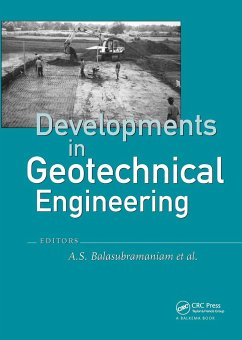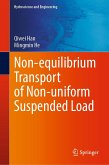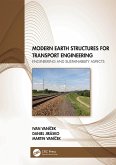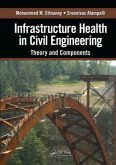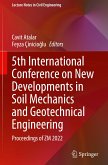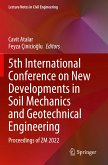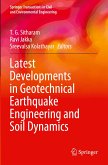A.S. Balasubramaniam / D.T. Bergado / S.W. Hong / P. Nutalaya / N. Phien-Wej (eds.)from Harvard to New Delhi 1936-1994
Developments in Geotechnical Engineering
from Harvard to New Delhi 1936-1994
Herausgeber: Balasubramaniam, A S; Hong, S W; Bergado, D T
A.S. Balasubramaniam / D.T. Bergado / S.W. Hong / P. Nutalaya / N. Phien-Wej (eds.)from Harvard to New Delhi 1936-1994
Developments in Geotechnical Engineering
from Harvard to New Delhi 1936-1994
Herausgeber: Balasubramaniam, A S; Hong, S W; Bergado, D T
- Gebundenes Buch
- Merkliste
- Auf die Merkliste
- Bewerten Bewerten
- Teilen
- Produkt teilen
- Produkterinnerung
- Produkterinnerung
This book reviews the developments that have taken place in the field of geotechnical engineering since the first international conference on Soil Mechanics and Foundation Engineering was held in Harvard University in 1936 until the January 1994 conference in New Delhi, India.
Andere Kunden interessierten sich auch für
![Non-equilibrium Transport of Non-uniform Suspended Load Non-equilibrium Transport of Non-uniform Suspended Load]() Qiwei HanNon-equilibrium Transport of Non-uniform Suspended Load128,99 €
Qiwei HanNon-equilibrium Transport of Non-uniform Suspended Load128,99 €![Modern Earth Structures for Transport Engineering Modern Earth Structures for Transport Engineering]() Vaní &Modern Earth Structures for Transport Engineering126,99 €
Vaní &Modern Earth Structures for Transport Engineering126,99 €![Infrastructure Health in Civil Engineering Infrastructure Health in Civil Engineering]() Mohammed M EttouneyInfrastructure Health in Civil Engineering174,99 €
Mohammed M EttouneyInfrastructure Health in Civil Engineering174,99 €![5th International Conference on New Developments in Soil Mechanics and Geotechnical Engineering 5th International Conference on New Developments in Soil Mechanics and Geotechnical Engineering]() 5th International Conference on New Developments in Soil Mechanics and Geotechnical Engineering208,99 €
5th International Conference on New Developments in Soil Mechanics and Geotechnical Engineering208,99 €![5th International Conference on New Developments in Soil Mechanics and Geotechnical Engineering 5th International Conference on New Developments in Soil Mechanics and Geotechnical Engineering]() 5th International Conference on New Developments in Soil Mechanics and Geotechnical Engineering208,99 €
5th International Conference on New Developments in Soil Mechanics and Geotechnical Engineering208,99 €![Soil, Agriculture, and Ecosystem Modeling Soil, Agriculture, and Ecosystem Modeling]() Soil, Agriculture, and Ecosystem Modeling209,99 €
Soil, Agriculture, and Ecosystem Modeling209,99 €![Latest Developments in Geotechnical Earthquake Engineering and Soil Dynamics Latest Developments in Geotechnical Earthquake Engineering and Soil Dynamics]() Latest Developments in Geotechnical Earthquake Engineering and Soil Dynamics164,99 €
Latest Developments in Geotechnical Earthquake Engineering and Soil Dynamics164,99 €-
-
-
This book reviews the developments that have taken place in the field of geotechnical engineering since the first international conference on Soil Mechanics and Foundation Engineering was held in Harvard University in 1936 until the January 1994 conference in New Delhi, India.
Hinweis: Dieser Artikel kann nur an eine deutsche Lieferadresse ausgeliefert werden.
Hinweis: Dieser Artikel kann nur an eine deutsche Lieferadresse ausgeliefert werden.
Produktdetails
- Produktdetails
- Verlag: Taylor & Francis
- Seitenzahl: 593
- Erscheinungstermin: 1. Januar 1994
- Englisch
- Abmessung: 254mm x 178mm x 33mm
- Gewicht: 1243g
- ISBN-13: 9789054105220
- ISBN-10: 9054105224
- Artikelnr.: 24838322
- Herstellerkennzeichnung
- Libri GmbH
- Europaallee 1
- 36244 Bad Hersfeld
- gpsr@libri.de
- Verlag: Taylor & Francis
- Seitenzahl: 593
- Erscheinungstermin: 1. Januar 1994
- Englisch
- Abmessung: 254mm x 178mm x 33mm
- Gewicht: 1243g
- ISBN-13: 9789054105220
- ISBN-10: 9054105224
- Artikelnr.: 24838322
- Herstellerkennzeichnung
- Libri GmbH
- Europaallee 1
- 36244 Bad Hersfeld
- gpsr@libri.de
A.S. Balasubramaniam (Edited by) , D.T. Bergado (Edited by) , S.W. Hong (Edited by) , P. Nutalaya (Edited by) , N. Phien-Wej (Edited by
Developments of theory and practice in geotechnical engineering (including
soil sampling, laboratory and field testing, design methods and
construction works) 1. Contributions in geotechnical engineering: Soil
mechanics and foundation engineering 2. Plasticity analysis in geotechnical
engineering: From theory to practice 3. Recent developments in in-situ
testing and performance monitoring of soil and rock structures 4. Some
unconventional field testing methods for earth materials 5. It took 2000
years of penetration to arrive at the Amap' Sols static-dynamic
penetrometer 6. Measurement of ground vibrations 7. Evaluation of in-situ
liquefaction resistance of sands based on high-quality undisturbed samples
8. Mechanism in the formation of kink bands 9. State parameter of granular
soils 10. Multi-stage triaxial compression test under a constant cell
pressure 11. The correlation between some Dutch-cone penetrometer results
and soil properties in some areas of Indonesia 12. Horizontal mass
permeability of a clay stratum Engineering behaviour of soils (including
collapsible and expansive as well as other problematic soils) 13. Effect of
coarse inclusions on strength of residual/colluvial soils 14. Experience
with swelling and collapsing soils 15. Swelling and collapsible behaviour
of arid soils 16. Geomorphology as the prime determinant of current
engineering problems in the TamarRiver basin at Launceston 17. The static
and dynamic properties of schistous sands 18. Black cotton soils - Highly
expansive clays of India Natural hazards and environmental geotechniques
19. Seismic deformations in embankments and slopes 20. Civil engineering
use of industrial waste in Japan 21. Seepage study for design of an
offshore waste containment bund 22. Liquefaction-induced earth movements
and mitigation in an earthquake-prone area 23. Vertical barriers for
municipal and hazardous waste containment 24. Decontamination and
rehabilitation of contaminated sites 25. Geotechnical risk assessment -
Different perspectives 26. Environmental effects on critical strain of
rocks 27. Application of satellite technology to environmental
geotechnology 28. In-situ testing methods for groundwater contamination
studies Embankments, excavations and buried structures 29. Embankments on
soft clays, a continuing challenge of misspent efforts 30. Stage
construction of embankments on soft soils 31. Unmanned excavation systems
in pneumatic caissons 32. Design methodology and experiences with pile
supported embankments 33. Innovation in buried infrastructure 34.
Warragamba Dam - A case study of environmental implications of the building
of a hydraulic structure 35. Experience of design of large dams on soft
rocks in Pakistan 36. Some remarks on the stability of towers 37. Remedial
treatment for Menjer concrete gravity dam (Indonesia) 38. Efficient driving
of precast concrete piles Soil-structure interactions 39. Piles subjected
to externally-imposed soil movements 40. Cost-effective use of friction
piles in non-cohesive soils 41. Response of block foundations in vertical
vibrations 42. Prediction of movement and behavior of sheet pile wall for
deep braced cut excavation in soft Bangkok clay 43. Ultimate uplift
capacity and shaft resistance of metal piles in clay Ground improvement
techniques 44. Use of geotextiles in railway track rehabilitation 45.
Japanese reclamation techniques for coastal and offshore areas with soft
foundation 46. The 'reinforced soil' in the future of geotechnics 47.
Engineering of ground in lowlands 48. Performance of reinforced embankment
on soft Bangkok clay with high strength geotextile reinforcement
soil sampling, laboratory and field testing, design methods and
construction works) 1. Contributions in geotechnical engineering: Soil
mechanics and foundation engineering 2. Plasticity analysis in geotechnical
engineering: From theory to practice 3. Recent developments in in-situ
testing and performance monitoring of soil and rock structures 4. Some
unconventional field testing methods for earth materials 5. It took 2000
years of penetration to arrive at the Amap' Sols static-dynamic
penetrometer 6. Measurement of ground vibrations 7. Evaluation of in-situ
liquefaction resistance of sands based on high-quality undisturbed samples
8. Mechanism in the formation of kink bands 9. State parameter of granular
soils 10. Multi-stage triaxial compression test under a constant cell
pressure 11. The correlation between some Dutch-cone penetrometer results
and soil properties in some areas of Indonesia 12. Horizontal mass
permeability of a clay stratum Engineering behaviour of soils (including
collapsible and expansive as well as other problematic soils) 13. Effect of
coarse inclusions on strength of residual/colluvial soils 14. Experience
with swelling and collapsing soils 15. Swelling and collapsible behaviour
of arid soils 16. Geomorphology as the prime determinant of current
engineering problems in the TamarRiver basin at Launceston 17. The static
and dynamic properties of schistous sands 18. Black cotton soils - Highly
expansive clays of India Natural hazards and environmental geotechniques
19. Seismic deformations in embankments and slopes 20. Civil engineering
use of industrial waste in Japan 21. Seepage study for design of an
offshore waste containment bund 22. Liquefaction-induced earth movements
and mitigation in an earthquake-prone area 23. Vertical barriers for
municipal and hazardous waste containment 24. Decontamination and
rehabilitation of contaminated sites 25. Geotechnical risk assessment -
Different perspectives 26. Environmental effects on critical strain of
rocks 27. Application of satellite technology to environmental
geotechnology 28. In-situ testing methods for groundwater contamination
studies Embankments, excavations and buried structures 29. Embankments on
soft clays, a continuing challenge of misspent efforts 30. Stage
construction of embankments on soft soils 31. Unmanned excavation systems
in pneumatic caissons 32. Design methodology and experiences with pile
supported embankments 33. Innovation in buried infrastructure 34.
Warragamba Dam - A case study of environmental implications of the building
of a hydraulic structure 35. Experience of design of large dams on soft
rocks in Pakistan 36. Some remarks on the stability of towers 37. Remedial
treatment for Menjer concrete gravity dam (Indonesia) 38. Efficient driving
of precast concrete piles Soil-structure interactions 39. Piles subjected
to externally-imposed soil movements 40. Cost-effective use of friction
piles in non-cohesive soils 41. Response of block foundations in vertical
vibrations 42. Prediction of movement and behavior of sheet pile wall for
deep braced cut excavation in soft Bangkok clay 43. Ultimate uplift
capacity and shaft resistance of metal piles in clay Ground improvement
techniques 44. Use of geotextiles in railway track rehabilitation 45.
Japanese reclamation techniques for coastal and offshore areas with soft
foundation 46. The 'reinforced soil' in the future of geotechnics 47.
Engineering of ground in lowlands 48. Performance of reinforced embankment
on soft Bangkok clay with high strength geotextile reinforcement
Developments of theory and practice in geotechnical engineering (including
soil sampling, laboratory and field testing, design methods and
construction works) 1. Contributions in geotechnical engineering: Soil
mechanics and foundation engineering 2. Plasticity analysis in geotechnical
engineering: From theory to practice 3. Recent developments in in-situ
testing and performance monitoring of soil and rock structures 4. Some
unconventional field testing methods for earth materials 5. It took 2000
years of penetration to arrive at the Amap' Sols static-dynamic
penetrometer 6. Measurement of ground vibrations 7. Evaluation of in-situ
liquefaction resistance of sands based on high-quality undisturbed samples
8. Mechanism in the formation of kink bands 9. State parameter of granular
soils 10. Multi-stage triaxial compression test under a constant cell
pressure 11. The correlation between some Dutch-cone penetrometer results
and soil properties in some areas of Indonesia 12. Horizontal mass
permeability of a clay stratum Engineering behaviour of soils (including
collapsible and expansive as well as other problematic soils) 13. Effect of
coarse inclusions on strength of residual/colluvial soils 14. Experience
with swelling and collapsing soils 15. Swelling and collapsible behaviour
of arid soils 16. Geomorphology as the prime determinant of current
engineering problems in the TamarRiver basin at Launceston 17. The static
and dynamic properties of schistous sands 18. Black cotton soils - Highly
expansive clays of India Natural hazards and environmental geotechniques
19. Seismic deformations in embankments and slopes 20. Civil engineering
use of industrial waste in Japan 21. Seepage study for design of an
offshore waste containment bund 22. Liquefaction-induced earth movements
and mitigation in an earthquake-prone area 23. Vertical barriers for
municipal and hazardous waste containment 24. Decontamination and
rehabilitation of contaminated sites 25. Geotechnical risk assessment -
Different perspectives 26. Environmental effects on critical strain of
rocks 27. Application of satellite technology to environmental
geotechnology 28. In-situ testing methods for groundwater contamination
studies Embankments, excavations and buried structures 29. Embankments on
soft clays, a continuing challenge of misspent efforts 30. Stage
construction of embankments on soft soils 31. Unmanned excavation systems
in pneumatic caissons 32. Design methodology and experiences with pile
supported embankments 33. Innovation in buried infrastructure 34.
Warragamba Dam - A case study of environmental implications of the building
of a hydraulic structure 35. Experience of design of large dams on soft
rocks in Pakistan 36. Some remarks on the stability of towers 37. Remedial
treatment for Menjer concrete gravity dam (Indonesia) 38. Efficient driving
of precast concrete piles Soil-structure interactions 39. Piles subjected
to externally-imposed soil movements 40. Cost-effective use of friction
piles in non-cohesive soils 41. Response of block foundations in vertical
vibrations 42. Prediction of movement and behavior of sheet pile wall for
deep braced cut excavation in soft Bangkok clay 43. Ultimate uplift
capacity and shaft resistance of metal piles in clay Ground improvement
techniques 44. Use of geotextiles in railway track rehabilitation 45.
Japanese reclamation techniques for coastal and offshore areas with soft
foundation 46. The 'reinforced soil' in the future of geotechnics 47.
Engineering of ground in lowlands 48. Performance of reinforced embankment
on soft Bangkok clay with high strength geotextile reinforcement
soil sampling, laboratory and field testing, design methods and
construction works) 1. Contributions in geotechnical engineering: Soil
mechanics and foundation engineering 2. Plasticity analysis in geotechnical
engineering: From theory to practice 3. Recent developments in in-situ
testing and performance monitoring of soil and rock structures 4. Some
unconventional field testing methods for earth materials 5. It took 2000
years of penetration to arrive at the Amap' Sols static-dynamic
penetrometer 6. Measurement of ground vibrations 7. Evaluation of in-situ
liquefaction resistance of sands based on high-quality undisturbed samples
8. Mechanism in the formation of kink bands 9. State parameter of granular
soils 10. Multi-stage triaxial compression test under a constant cell
pressure 11. The correlation between some Dutch-cone penetrometer results
and soil properties in some areas of Indonesia 12. Horizontal mass
permeability of a clay stratum Engineering behaviour of soils (including
collapsible and expansive as well as other problematic soils) 13. Effect of
coarse inclusions on strength of residual/colluvial soils 14. Experience
with swelling and collapsing soils 15. Swelling and collapsible behaviour
of arid soils 16. Geomorphology as the prime determinant of current
engineering problems in the TamarRiver basin at Launceston 17. The static
and dynamic properties of schistous sands 18. Black cotton soils - Highly
expansive clays of India Natural hazards and environmental geotechniques
19. Seismic deformations in embankments and slopes 20. Civil engineering
use of industrial waste in Japan 21. Seepage study for design of an
offshore waste containment bund 22. Liquefaction-induced earth movements
and mitigation in an earthquake-prone area 23. Vertical barriers for
municipal and hazardous waste containment 24. Decontamination and
rehabilitation of contaminated sites 25. Geotechnical risk assessment -
Different perspectives 26. Environmental effects on critical strain of
rocks 27. Application of satellite technology to environmental
geotechnology 28. In-situ testing methods for groundwater contamination
studies Embankments, excavations and buried structures 29. Embankments on
soft clays, a continuing challenge of misspent efforts 30. Stage
construction of embankments on soft soils 31. Unmanned excavation systems
in pneumatic caissons 32. Design methodology and experiences with pile
supported embankments 33. Innovation in buried infrastructure 34.
Warragamba Dam - A case study of environmental implications of the building
of a hydraulic structure 35. Experience of design of large dams on soft
rocks in Pakistan 36. Some remarks on the stability of towers 37. Remedial
treatment for Menjer concrete gravity dam (Indonesia) 38. Efficient driving
of precast concrete piles Soil-structure interactions 39. Piles subjected
to externally-imposed soil movements 40. Cost-effective use of friction
piles in non-cohesive soils 41. Response of block foundations in vertical
vibrations 42. Prediction of movement and behavior of sheet pile wall for
deep braced cut excavation in soft Bangkok clay 43. Ultimate uplift
capacity and shaft resistance of metal piles in clay Ground improvement
techniques 44. Use of geotextiles in railway track rehabilitation 45.
Japanese reclamation techniques for coastal and offshore areas with soft
foundation 46. The 'reinforced soil' in the future of geotechnics 47.
Engineering of ground in lowlands 48. Performance of reinforced embankment
on soft Bangkok clay with high strength geotextile reinforcement

